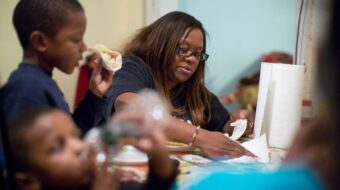
This is the second in a series of articles on aging in America that will appear on People’s World as we look back on 50 years of the Older Americans Act. Other articles in the Aging in America Series can be read here.
Last week, as President Obama signed the Older Americans Act reauthorization (OAA), people of all ages were volunteering hundreds of hours of their time to provide low-income older adults with simple but lifesaving services that go unfunded or underfunded by both state and federal programs. Adding to the insult of meager funding, most seniors find the injury of a byzantine patchwork of federal and state services and benefits to be overwhelming and sometimes outright impossible to navigate alone.
Nevertheless, programs such as Meals-On-Wheels, in-home services, transportation, legal services, elder abuse prevention, and caregivers support are often the lifelines which enable our aging population to stay in their homes and in the community. Along with Social Security, Medicare, Medicaid and the Supplemental Nutrition Assistance Program (SNAP), the programs and services funded by the OAA are essential to millions of older adults.
But as the press corps leaves the White House signing ceremony and media attention dwindles, our older co-workers, friends, parents, and grandparents will continue to be forced to make cruel decisions in order to pay their rent, heat, grocery, and medical bills. Millions of older Americans, some of whom served alongside our allies to defeat fascism in Europe and Asia, are themselves the outcasts of a society whose priorities, politics and economic system, have turned against them in their time of need.
Instead of a life lived in dignity, many senior citizens are having to scrimp, accept charitable hand-outs, and are often forced to decide whether to pay for much-needed medicine, or go hungry. Far from being an anomaly, the National Council on Aging reports that one in three, or a total of 25 million, older Americans is economically insecure. Over nine million, or one in six older adults, faces hunger. Perhaps most shocking, between 2001 and 2014, the number of older adults experiencing serious economic and food insecurity has doubled.
As the need increases, it should not be surprising that we are seeing a dramatic increase in older people participating in the labor force and living in poverty. But according to a recent study–ironically funded by a private health care and insurance company’s foundation–these same federal statistics on poverty may be severely underestimating the underlying crisis. According to this study, the official poverty measure and the Supplemental Poverty Measure (SPM), which is held to be more effective and detailed, differ significantly. Despite its superiority as a tool of measurement, SMP is not used in the development of poverty statistics for older Americans.
Aside from the numbers of older adults living in poverty, SPM points to larger disparities in poverty between older white males and African Americans, Hispanics, and women than we see in the official statistics. For example, in 2013 Hispanic adults over 65 represented 20 percent of all 65+ seniors living in poverty using the official poverty measure. Using SPM, that number grew to 28 percent Hispanic. Similarly, for African Americans, the official measure showed 18 percent, versus 22 percent using SPM.
Incredibly, the official poverty measure does not factor cost-of-living disparities throughout the U.S., and instead focuses on age-based tiers. Alternatively, SPM provides for Localized Threshold Adjustments, which are based on real-world factors such as food and housing costs.
The end result of an analysis using SPM is the stark revelation that Congress and policymakers are working under the assumption of inaccurately low poverty rates among the aging population, and they are prioritizing accordingly. Without proper advocacy at both the state and federal level, this low-balling could snowball into one of the worst human disasters in U.S. history.
If we want to get a picture of how this statistical disparity pans out across the more populous urban parts of the U.S., we need to look at specific areas. As an example, I live and work with older adults in Massachusetts. The official poverty measure reports 8 percent of our senior citizens living in poverty, but in the naked light of SPM, that number doubles, to 16 percent. It would seem this discrepancy has the potential to inflict catastrophic consequences as the older population bubble continues to inflate over the next 30 years.
As the World War II generation knows from personal experience, confronting national and international challenges such as these requires unity, education, analysis, and skillful leadership, as well as determination. Knowing these factors is an important starting place for analyzing the demographic, economic, and political terrain.
Working people and working class older adults will need to come together to build a viable, symbiotic, and politically cohesive force for claiming and enshrining economic, social, and cultural rights, just as previous generations led the way in championing our civil and political rights.
Donald Donato is a writer, priest, and human services advocate from Boston. He has worked with community-based organizations in support of economic, social, and cultural rights as human rights for over a decade, and he is currently the Area Planner and grant writer for an Area Agency on Aging near Boston.
Photo: HeartlandAlliance.org










